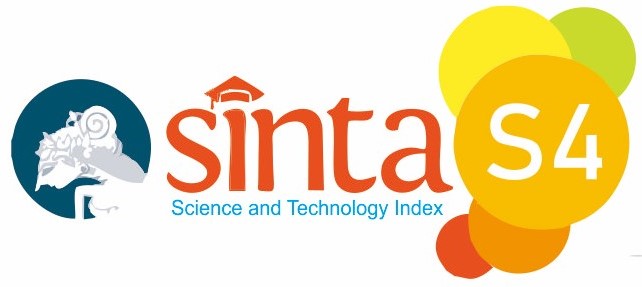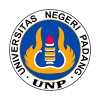REVIEW OF INFORMATION SUPPORT FROM UNIVERSITIES AS A MOTIVATING FACTOR FOR STUDENTS TO PARTICIPATE IN STUDENT CREATIVITY PROGRAMS
Abstract
The Student Creativity Program (PKM) is initiated by Dikjen Diktirestik through Belmawa to fulfill one of the 8 Key Performance Indicators (IKU) of Higher Education, focusing on graduates' success in securing suitable employment and providing students with off-campus experiences. The Department of Mechanical Engineering at FT-UNP actively participates in PKM each year. Therefore, this study aims to thoroughly examine the influence of University Information Support as a catalyst for the participation of Mechanical Engineering students in PKM. The research employs a quantitative approach involving 282 Mechanical Engineering students, validating instruments and collecting data. Data analysis is conducted researchers utilized the SmartPLS application for conducting Structural Equation Modeling (SEM) in their study. Findings reveal that University Information Support has a significant positive impact on student participation in PKM at the FT-UNP Mechanical Engineering Department, indicated by a Path Coefficient 0.189, T statistics 2.621, and P values 0.009. University Information Support is crucial in enhancing student involvement in the Student Creativity Program, underscoring the importance of adequate information provision by universities.
References
Abbas, A., Masri, D., Prayitno, P., Hasanuddin, H., Zaenuddin, Z., Yuridka, F., Raharjo, M. R., & Anwar, Y. (2022). ARAS Algorithm as Decision Support System’s Technique for Selection Student Creativity Program. Journal of Physics: Conference Series, 2394(1), 012003. https://doi.org/10.1088/1742-6596/2394/1/012003
Arikunto, S. (2006). Prosedur Penelitian Suatu Pendekatan Praktik (Revisi VI). PT Rineka Cipta.
Arsiyana, M., Purwani, N., & Pudjitriherwanti, A. (2021). Workshop dan Pendampingan Penulisan Proposal Program Kreativitas Mahasiswa (PKM) sebagai Upaya Menumbuhkan Minat Mahasiswa terhadap Karya Tulis Ilmiah. Varia Humanika, 2(2), 141–146. https://doi.org/10.15294/vh.v2i2.51328
Castro, M. D. B., & Tumibay, G. M. (2021). A literature review: efficacy of online learning courses for higher education institution using meta-analysis. Education and Information Technologies, 26(2), 1367–1385. https://doi.org/10.1007/s10639-019-10027-z
Deci, E. L., & Ryan, R. M. (1985). Intrinsic Motivation and Self-Determination in Human Behavior. Springer US. https://doi.org/10.1007/978-1-4899-2271-7
Ghozali, I., & Latan, H. (2015). Partial Least Squares : Konsep, Teknik dan Aplikasi Menggunakan Program SmartPLS 3.0, -2/E. Badan Penerbit Undip.
Giesenbauer, B., & Müller-Christ, G. (2020). University 4.0: Promoting the Transformation of Higher Education Institutions toward Sustainable Development. Sustainability, 12(8), 3371. https://doi.org/10.3390/su12083371
Gleason, N. W. (2018). Higher Education in the Era of the Fourth Industrial Revolution (N. W. Gleason, Ed.). Springer Singapore. https://doi.org/10.1007/978-981-13-0194-0
Hadjar, I. (1996). Dasar-dasar metodologi penelitian kwantitatif dalam pendidikan (1st ed.). Raja Grafindo Persada.
Hair, J. F., Black, W. C., Babin, B. J., & Anderson, R. E. (2019). Multivariate Data Analysis. Cengage Learning.
Hair, J. F., Sarstedt, M., Ringle, C. M., & Mena, J. A. (2012). An assessment of the use of partial least squares structural equation modeling in marketing research. Journal of the Academy of Marketing Science, 40(3), 414–433. https://doi.org/10.1007/s11747-011-0261-6
Hecklau, F., Galeitzke, M., Flachs, S., & Kohl, H. (2016). Holistic Approach for Human Resource Management in Industry 4.0. Procedia CIRP, 54, 1–6. https://doi.org/10.1016/j.procir.2016.05.102
Ifenthaler, D., & Yau, J. Y.-K. (2020). Utilising learning analytics to support study success in higher education: a systematic review. Educational Technology Research and Development, 68(4), 1961–1990. https://doi.org/10.1007/s11423-020-09788-z
Ismail, I., Putri, R. S., Zulfadhli, Z., Mustofa, A., Musfiana, M., & Hadiyani, R. (2022). Student Motivation to Follow the Student Creativity Program. Riwayat: Educational Journal of History and Humanities, 5(2), 351–360. https://doi.org/10.24815/jr.v5i2.27641
Kuh, G. D., Kinzie, J., Buckley, J. A., Bridges, B. K., & Hayek, J. C. (2006). What Matters to Student Success: A Review of the Literature Commissioned Report for the National Symposium on Postsecondary Student Success: Spearheading a Dialog on Student Success.
Listiani, N. M. (2017). Pengaruh Kreativitas dan Motivasi Terhadap Hasil Belajar Mata Pelajaran Produktif Pemasaran pada Siswa Kelas XI SMK Negeri 2 Tuban. JURNAL EKONOMI PENDIDIKAN DAN KEWIRAUSAHAAN, 2(2), 263. https://doi.org/10.26740/jepk.v2n2.p263-275
Lizzio, A., & Wilson, K. (2004). Action Learning in Higher Education: an investigation of its potential to develop professional capability. Studies in Higher Education, 29(4), 469–488. https://doi.org/10.1080/0307507042000236371
Marliana, R. R. (2019). Partial Least Square-Structural Equation Modeling Pada Hubungan antara Tingkat Kepuasan Mahasiswa dan Kualitas Google Classroom Berdasarkan Metode Webqual 4.0. Jurnal Matematika, Statistika Dan Komputasi, 16(2), 174. https://doi.org/10.20956/jmsk.v16i2.7851
Muskhir, M., Luthfi, A., Julian, R., & Fortuna, A. (2023). Exploring iSpring Suite for Android-Based Interactive Instructional Media in Electrical Lighting Installation Subject. International Journal of Interactive Mobile Technologies (IJIM), 17(22), 67–84. https://doi.org/10.3991/ijim.v17i22.42625
Nasrullah, H., Wanty, E. S., & Wibowo, A. (2022). Prediction of Feasibility of Entrepreneurial Proposals in Student Creativity Program. JOURNAL OF INFORMATICS AND TELECOMMUNICATION ENGINEERING, 6(1), 113–125. https://doi.org/10.31289/jite.v6i1.7253
Notoatmodjo, S. (2003). Pengantar pendidikan kesehatan dan ilmu perilaku kesehatan. Andi Offset.
Nulhaqim, S. A., Heryadi, D. H., Pancasilawan, R., & Ferdryansyah, M. (2016). Peranan Perguruan Tinggi dalam Meningkatkan Kualitas Pendidikan di Indonesia untuk Menghadapi Asean Community 2015 Studi Kasus: Universitas Indonesia, Universitas Padjadjaran, Institut Teknologi Bandung. Share : Social Work Journal, 6(2), 197. https://doi.org/10.24198/share.v6i2.13209
Pratiwi, Y., & Wardana, I. (2016). Pengaruh Faktor Internal dan Eksternal Terhadap Minat Berwirausaha Mahasiswa Fakultas Ekonomi dan Bisnis Universitas Udayana. E-Jurnal Manajemen, 5–5. https://ojs.unud.ac.id/index.php/manajemen/article/view/22691
Ryan, R. M., & Deci, E. L. (2000). Self-determination theory and the facilitation of intrinsic motivation, social development, and well-being. American Psychologist, 55(1), 68–78. https://doi.org/10.1037/0003-066X.55.1.68
Sianturi, L., Hutauruk, S., Sigiro, M., Siallagan, H., & Simanjuntak, J. (2023). Program Kemahasiswaan Dalam Pemenuhan Indikator Kinerja Utama (IKU) Perguruan Tinggi – Best Practice. Jurnal Visi Pengabdian Kepada Masyarakat, 4(1), 32–42. https://doi.org/10.51622/pengabdian.v4i1.1138
Sriasih, S. A. P., Nitiasih, P. K., Jayaputra, I. N. A., Budasi, I. G., & Budi Utama, I. D. G. (2020). Problematika Program Kreativitas Mahasiswa (PKM) Dan Program Mahasiswa Wirausaha (PMW) Pada Fakultas Bahasa dan Seni Undiksha. PRASI, 15(01), 22. https://doi.org/10.23887/prasi.v15i01.24801
Sumaryanto, S., Kasse, T., & Putro, N. H. P. S. (2019). Revisiting the determinants of students’ success in conducting creativity program. Jurnal Cakrawala Pendidikan, 38(1), 90–103. https://doi.org/10.21831/cp.v38i1.22916
Tinto, V. (1993). Leaving college: Rethinking the causes and cures of student attrition (2nd ed.). University of Chicago Press.
Wibowo, A., Pranoto, H., & Restiana, R. A. (2021). Hubungan antara Citra Tubuh (Body Image) terhadap Hubungan Interpersonal. Counseling Milenial (CM), 3(1), 108–119. https://doi.org/10.24127/konselor.v3i1.1813
Zuhdi, Z., Suharjo, B., & Sumano, H. (2016). Perbandingan Pendugaan Parameter Koefisien Struktural Model Melalui Sem dan Pls-Sem. Journal of Mathematics and Its Applications, 15(2), 11–22. https://doi.org/10.29244/jmap.15.2.11-22
Submitted
Copyright (c) 2024 Jurnal Vokasi Mekanika

This work is licensed under a Creative Commons Attribution 4.0 International License.








.svg_.png)


